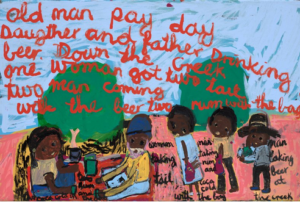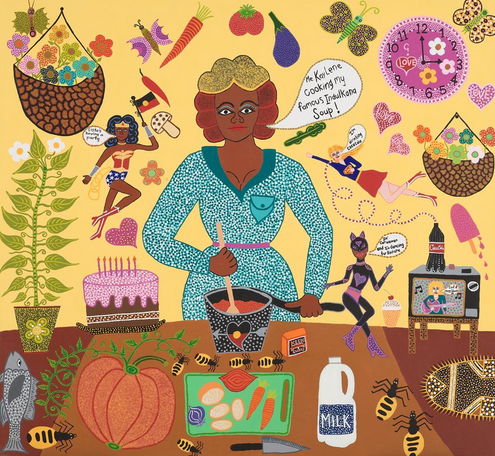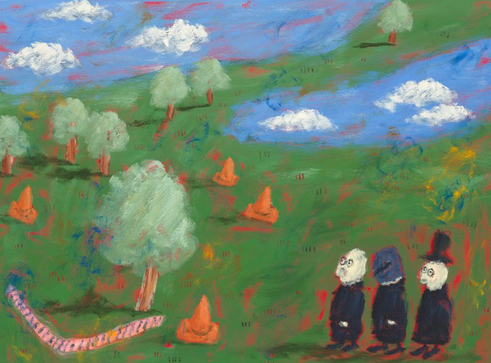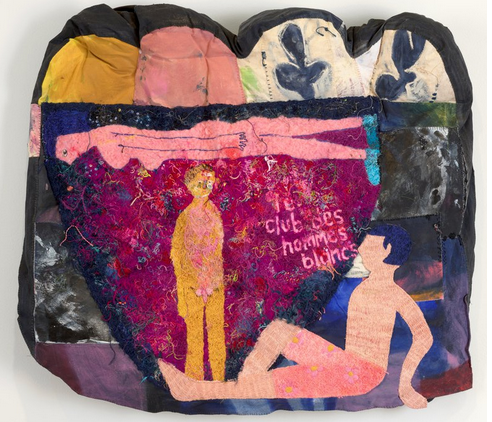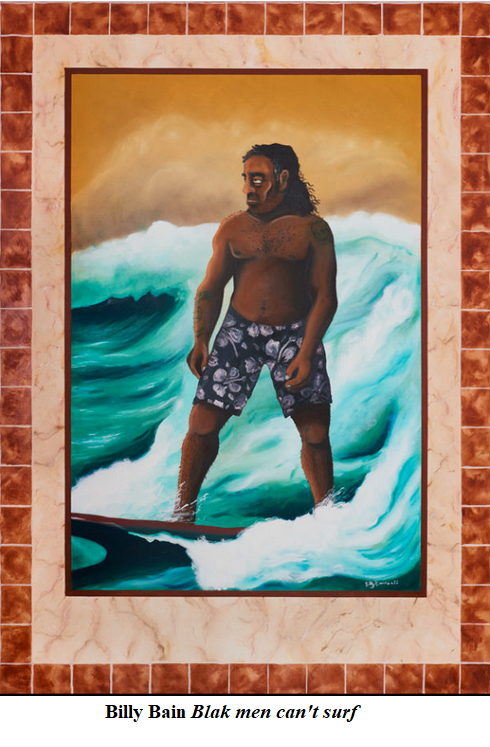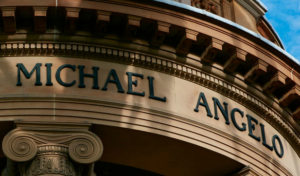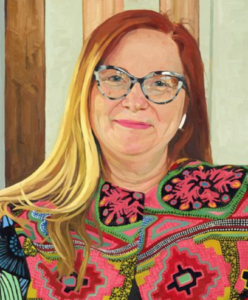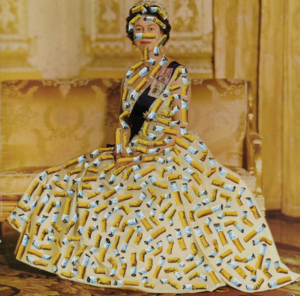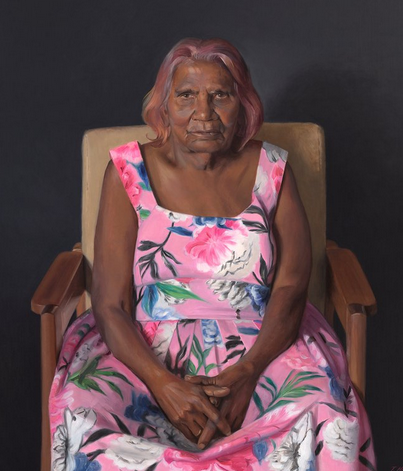Tony Thomas
Sydney’s a beautiful city, as I rediscover on a trip after long absence. But what the hell, it’s gone bonkers. Why is it subjecting visitors to such a deluge of woke propaganda? The impression I get is that 99.4 per cent of Sydney’s citizens vote for the Greens and Sydney’s Yes support for the referendum will be 100 per cent.
I meander to the NSW Art Gallery, which looks out to the Harbour Bridge flying its twinned Australian and Aboriginal flags. “We are two, but we are many,” pipe those Qantas kids. A blue and white city bus whirrs past be-painted, “This is a zero emissions bus. Breathe easy.” I breathe easily, not too fussed about the short-lived Congo kids who scrabble slave-like for cobalt for bus batteries.
Going up the Gallery steps to enjoy the Archibald entries, I look up at the empty bays on the left for Donatello, Cellini, Canova etc and on the right the four sculpted bays for Giotto, Raphael, Titian and Rembrandt. But what’s this in shadow in the centre of the portico? Six scrawled heads in masks or spit-hoods. This work, I discover, is by cross-cultural Wiradjuri woman Karla Dickens and is “an unflinching interrogation of post-contact Aboriginal experiences and the continuing legacies of colonialism and patriarchy.”
Thus counselled, I trudge humbly into the big hall. On the right, stretching for a good ten metres, are 42 glum photographs of unsmiling Aborigines by Brenda Croft of “Kamberri”, a city in the ACT. I check the names for Aunty Matilda House, but she fails to get a guernsey – perhaps because she’s not glum enough. She opened Parliament in 2013. Payment for“Entertainment Services”: $10,500.
Across the left wall is “Have a Think About It”: five works by Perth artist Abdul Abdullah, showing rocks with cartoonish faces drawn on them. The curators aren’t sure what to think about it, but take a safe guess involving “images of turbulent oceans used in campaigns to deter people from seeking asylum in Australia.” Sure, and I blame Tony Abbott.[1]
Downstairs I go to the Archibald and Sulman finalist show — will it include any agitprop? Will it ever!
Inside is Judith Sinnamon’s sunny portrait of a dear friend of Malcolm Turnbull, his “Murpharoo” (left). In her spare time she’s Katherine Murphy, political editor of the Guardian Australia which Turnbull was godfather to, and omnipresent chatterbox on their ABC. As far as I know, she’s not Aboriginal but her portrait has made the finals regardless. According to artist Ms Sinnamon, Murpharoo
brings a refreshing, cut-through perspective to the fug of Australian politics. I feel tremendous gratitude towards Katharine and all journalists of strong conviction and integrity, who speak truth to power at a time of rampant misinformation and media mogul influence. (My emphasis).
With her perch on the ABC, Murphy enjoys power rather than speaks truth to it. I assume the un-named media mogul is ABC chair Ita Buttrose who presides over her billion-a-year misinformation empire. The curators continue: “Sinnamon captures the award-winning journalist, with her colourful clothing and animated face, listening to the podcast Pod save America in her light-filled home.”[2]
Maybe one day some right-leaning artist will win the Archibald’s $100,000 with a portrait of Sky News host Rita Panhi in colourful clothing and animated face while listening to a Donald Trump podcast in her light-filled home. Or do I imagine a bridge too far?
Near Murpharoo is a portrait of a five-dollar banknote by Aboriginal artist Dr Ryan Presley called “Blood Money – infinite dollar note”. Instead of the late Elizabeth Windsor, it features Aunty Regina Pilawuk Wilson. Dr Presley’s done a set of these modified banknotes (another of which is below). The curators say his oeuvre explores “Australian history through a First Nations lens, and the damage wrought by exploitation.”
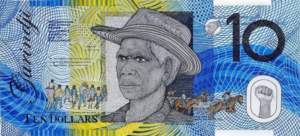
Dr Presley says that both Queen Elizabeth II and Aunty Regina “have a regal air: one substantiated by an empire and the consumption of colonialism; the other achieved through the great feat of reclaiming her (and her community’s) cultural identity in the face of colonialism.”
Presley’s five-dollar banknote is well-drawn with lots of the hard-to-counterfeit squiggles and hatchings, hence I’m surprised the Reserve Bank itself celebrates his project. If you get one in your change, hand it back.
Talking of Queen Elizabeth, I diverted to the Sulman Prize finalists, and who should be portrayed there but the late Queen (left). She’s in a robe comprised of cigarette butts, and her face and tiara are also outlined in bent fags. I counted about 250 butts, and commend the artist Philjames for his perseverance. He’s labelled the portrait “Ciggie-butt queen” and explains (my emphasis),
The work is a continuation of my cigarette-butt paintings, which are in essence still-life paintings, as each butt is painted from life. The works often question art history, in this case the institution of the monarchy.
Ciggie-butt queen shouldn’t be read as an assault on Her Royal Highness, the late Queen Elizabeth II, but preferably as a questioning of colonialism (of which I am a product) and the concept of a monarchy (which I find absurd). Ciggie-butt queen is a small act of rebellion; sometimes we need to destroy in order to rebuild.
Given Australia’s art mores and milieu, I’d say Philjames’ “small act of rebellion” is more a small act of conformity.
Back to the Archibalds, and I stop by a dramatic portrait of an Aboriginal woman getting ready for a smoking ceremony. It’s Yvonne Weldon (right), a Wiradjuri woman and the City of Sydney’s first Aboriginal councillor. The painting is called Barrambiyarra (Awaken). Artist Luke Cornish says he was inspired to paint her after seeing her do a “Welcome to Country” at this year’s Sydney Festival Vigil. I’m glad that at least one Australian enjoys being welcomed by Aborigines to Australia. Luke enthuses:
‘The painting encapsulates the spirit of First Nations peoples, motherhood and Mother Earth. The coolamon… is a vessel for burning leaves. Smoke is used ceremonially to cleanse and heal people, the land and waters. This ancient custom is shared today as a gesture of goodwill, bringing people together to promote healing.’
Actually I’m not sure smoking ceremonies are any more “ancient customs” than the “welcomes” cooked up by Ernie Dingo in Perth in 1976 (some say 1978).
The Archibald and Sulman finalists include quite a few Aboriginal artists drawing naïve and cartoonish scenes, which is certainly easier than how Vermeer and Velasquez did their stuff. These entries tend to be playful although some go for grievance agitprop. I liked the town-camp narrative picture “Old man pay day” by Sally Mulda (below), which she says shows
Daughter and father drinking beer. Down the creek one woman got two [kangaroo] tail. Two man coming with the beer two rum with the bag; Two rum and two coca cola in the bag.”
For some reason the curators writing the caption blame the Howard government’s 2007 Northern Territory intervention for poor housing, diet, and unsympathetic rangers, concluding “Her [Sally’s] practice represents an important catalogue of lived experience of town camp life and colonisation.”
I also liked Kaylene Whiskey’s obsession – even way out in APY lands – with her “hero” the mammiferous Dolly Parton. About her painting, “Cooking my famous Indulkana soup” (above) she writes,
“I’ve painted myself in the kitchen surrounded by vegetables and other ingredients – even some tjala (honey ants) – as well as some of my favourite kungka kunpu (strong women): Wonder Woman, Cat Woman, Supergirl and, of course, Dolly herself. If you want to be strong like a superhero, you have to eat healthy food.”
Ms Whiskey was a finalist in the 2020 Archibald “with a painting in which she imagined Dolly Parton dropping in for a quick visit. She is also a finalist in this year’s Sulman Prize – and Dolly once again appears. Whiskey won the Sulman Prize in 2018.” Sidney Nolan had his Ned Kelly; Kaylene Whiskey is doing well with Dolly Parton. Good on her.
An Archibald finalist is artist Tsering Hannaford who portrays Berry Malcolm (aka “Nanna Mara”), a respected Yindjibarndi Elder, cultural custodian, linguist, artist and yirramagayi (song composer) at Roebourne, WA, which the curators have re-named “Ieramugadu”. Hannaford sketched her (left) in the Roebourne Library and invited the locals to watch her do it. It’s a good portrait.
The artist explains, ‘I felt privileged to be welcomed to a beautiful part of Australia, with such a deep and rich history. It was special to sit with Nanna Mara as her portrait quietly unfolded, and to be able to share this with the Roebourne community.’
While it’s fine to stress the positives at Roebourne (pop. 1000 and falling), I couldn’t help but recall the headlines from six years back:
Town of the damned: the Australian town with ‘staggering’ child sex abuse rate…One Aussie town is in the grip of a paedophile epidemic, with 184 children sexually abused. Warning: Confronting. Police have charged 36 men with more than 300 offences against 184 children from Roebourne and surrounding communities. West Australian Police Commissioner Karl O’Callaghan has described the rate of alleged child sex offending in Roebourne as “staggering” and the problem as “a cancer”. It has now been singled out as a festering mess of intergenerational child sexual abuse where kids are more likely to be raped than almost anywhere else on earth. “It’s a war zone out there and the victims are little kids,” Mr O’Callaghan told the ABC. The scale of the abuse uncovered was the worst WA Police had ever seen and the communities were in an “almost unrecoverable crisis”, Mr O’Callaghan claimed.
At that time, according to police, 80 per cent of the community was living on welfare and child sex offenders were using their welfare payments to buy drugs and alcohol to lure children. The dysfunction at Roebourne in 2017 had been on-going for close to a decade. Has Roebourne already recovered from its “almost unrecoverable crisis” of 2017? It’s moot whether artists and NSW Gallery curators should be promoting Roebourne’s “deep and rich history”.
I mentioned Karla Dicken’s faces in spit-hoods at the entrance. Ms Dickens features again inside as a Sulman finalist for a landscape “Killer Cattle” (above) with a 3D cow’s head sticking out of it. She accompanies her painting with a Kathy Lette-style punning poem with global warming agitprop:
What’s at steak?
There are mumbles as the world crumbles…
Greenhouse gas kills greener pastures ahead…
Acid rain T-bones steer an offal lot of pollution
Clearing natives off the country
Let’s muster up these burping meth heads
Before porterhouse drives us to the poorhouse…
Calves tagged with monstrous environmental footprints
Meat global reduction targets and enjoy more greens…
Get off your rump and cut the bullock
What’s at steak?
The curators seize the opportunity to make kids even more miserable, telling them
“Karla Dickens creates art that tells stories and makes us think about important issues. This painting highlights the devastating impact of cattle and other introduced animals on Australian native species.”
Like-minded James Lai is a Sulman finalist with his work, “Wise guys on Ls negotiating the changing landscape”. He explains his masterpiece (below) mildly
My work explores humankind’s response to the threat of climate change. At first glance, the blue skies and green landscape don’t suggest the crisis that is significantly affecting our environment and wellbeing. My generation is witnessing the physical impacts of global warming and the adverse flow-on effects on our mental health and livelihood … The serpent and lush landscape – elements borrowed from the biblical Garden of Eden story about the fall of man – are analogous to climate change and its devastating impact.
For some reason a crude picture of a bean makes it to the Sulman finals with its slogan alongside, “Eat more beans” (below). Artist Michael Phillips explains the black/yellow/red picture,
It is imperative to rethink the present economic ecology – a failing system based on endless taking; a system responsible for the present environmental and social imbalances, both verging on catastrophic. Eat more beans is a broad cultural and environmental cry to shift our thinking on how we grow and repair our world…
As Canadian environmentalist Rebecca Tarbotton said:
‘What we’re really talking about, if we’re honest with ourselves, is transforming everything about the way we live on this planet.’ (My emphases).
Perhaps Eat More Beans is a methane typo, and should read, Eat Less Beans.
The Gallery and its artists really dislike the capitalism which nurtures them. A Sulman by Henry Curchod, “Entrepreneurs”, depicts a kid robbing other kids’ lemonade stall with a faux gun (below) . The curators explain,
“While seemingly sinister in its portrayal of an early adoption of capitalism, violence and wealth disparity, the work’s playful and vibrant application encourages a more innocent interpretation.” (My emphasis)
Sexy art used to involve female nudes. Not here, not anymore. Take Sulman finalist Nic Fern, whose work is called “The club: where real people become unreal men” (below). According to the artist, it
creates a contemporary version of French artist Edouard Manet’s Le déjeuner sur l’herbe (The luncheon on the grass, 1862-63).
So far so good. Mr Fern continues,
“It is my hope that all men are able to unburden themselves of their phallocentric armour, allowing them the freedom to choose their own masculinity without judgement or social consequence.”
That’s not the only Sulman on this theme. Another by Aboriginal artist Billy Bain is Blak men can’t surf, which parodies an old beer ad of a white surfer. Mr Bain writes,
“Subverting these colonial cultural iconographies undermines the pub and surfing subcultures’ history as a place of segregation and an epicentre of white masculinity.”
Maybe I’m just a grumpy white cisgender toxic male. Which artist do I apologise to first?
Tony Thomas’s new book from Connor Court is Anthem of the Unwoke – Yep! The other lot’s gone bonkers. For a copy ($35 including postage), email tthomas061@gmail.com
[1] “Working across portraiture, photography and painting, Abdullah uses his experience of growing up Muslim in the suburbs of Perth, and coming of age in a post–September 11 world, to expose the prejudices and stereotypes which have demonised and marginalised Muslim youth today.”
[2] The “Pod save America” podcast calls itself “a no-bullshit conversation” hosted by four former Obama aides. I’m not sure how an artist can paint a podcast but Murpharoo does have an ear-bud draped under her left ear.
